Par zanimivosti o največjem znanstvenem eksperimentu v zgodovini, velikem hadronskem trkalniku (Large Hadron Collider, LHC), ki je 30. marca okrog 13h trknil 2 snopa protonov, ki sta imela energijo 3.5 TeV (tera elektronvoltov). Energija tega trka je bila tako 7 TeV, kar predstavlja točno polovico največje zmogljivosti LHC-ja.
En elektronvolt (eV) je energija, ki jo pridobi en elektron, če preleti razliko potencialov en volt. Nekako tako, kot če spustiš jabolko s 3 metrov višine, in ko je dva metra nad tlemi, je preletelo razliko potencialov 1 meter (3m – 2m). Energija jabolka je enaka spremembi njegove potencialne energije, oz., po preprosti srednješolski formuli:
ΔWp = m * g * Δh, kjer je
m = masa,
g = 9.8 m/s2,
Δh pa višinska (to je, potencialna) razlika, ki jo preleti jabolko.
Sprememba potencialne energije jabolka, ki tehta 200 g in preleti 1 m v gravitacijskem polju, bi tako bila:
ΔWp = 0.2 kg * 9.8 m/s2 * 1 m
ΔWp = 1.96 Joula (J)
No, en elektron, ki bi na podoben način “padel” z enega na drug potencial v električnem polju in pri tem preletel potencialno razliko enega volta, pa bi na enak način pridobil samo 1.602×10−19 J energije (to je, 0.0000000000000000001602 J).
Energije v trkalniku so tera elektronvolti, (tera je naslednja večja enota od giga). Tera = 1012 oz. milijon milijonov (1.000.000.000.000). Tako ima proton z energijo 3.5 TeV z drugimi besedami energijo 0.00000056 J, oz. kot pravijo v CERN-u, energijo letenja komarja. Ni slabo za en sam proton.
Proton to energijo pridobi s kroženjem po tunelu z obsegom 27 km. Po celotnem obsegu sta položeni 2 cevi, ena za kroženje v smeri urinega kazalca, druga za obratno smer. V obeh ceveh je izjemno visok vakum, da se krožeči delci ne bi zaletavali v atome ali molekule plinov.
Delce v cevi držijo sistemom superprevodnih magnetov, ki so ohlajeni na 1.9 K (temperatura, hladnejša kot prostor med galaksijami). Pri tej temperaturi postanejo prevodniki (navitje elektromagneta) superprevodni, kar omogoča uporabo velikih tokov praktično brez izgub (izgube pomenijo segrevanje). Skozi magnete teče tok 13.000 amperov.
Curek protonov pospešijo do približno miljarde km/h (natančneje, do 99.9999991% svetlobne hitrosti, ki je najvišja mogoča hitrost), tako da obkrožijo celoten obroč pospeševalnika 11.000x v sekundi. Čeprav ima en proton le energijo letečega komarja, pa celoten curek nosi približno 360 MJ (milijonov Joulov), kar je enako energiji letalonosilke USS Ronald Reagan (103000 ton, polno naložena), ki pluje s 5 vozli (~10 km/h).

Pri taki energiji oba v nasprotnih smereh krožeča curka trknejo vkup (tj, kot bi tresknili skupaj 2 letalonosilki), razbitine, ki letijo v vse smeti, pa zajamejo s štirimi detektorji (ALICE, ATLAS, CMS in LHCb), ki so videti kot čista znanstvena fantastika.
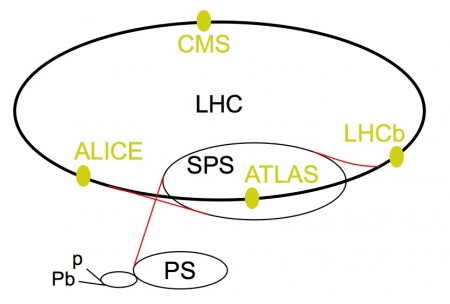
ALICE je na spodnji sliki.
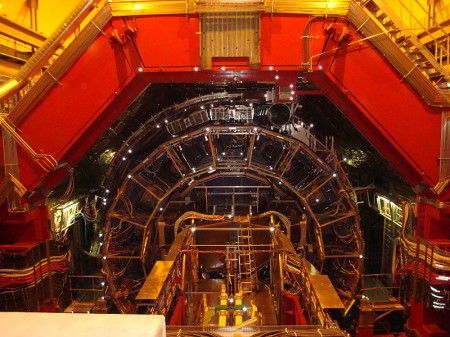
Detektorji v dnevu obratovanja sproducirajo 27 TB podatkov, oz. približno 5900 DVD-jev. Tule se vidi grafe za trke 30. marca, ko je bil throughput prenosa podatkov iz CERN-a do CASTOR-ja (CERN Advanced STORage manager) približno 4 Gbit/s.
Glavni cilj tega kolosalnega eksperimenta, vrednega 6,3 milijarde evrov, je iskanje Higgsovega bozona, ki je manjkajoči element v t.i. standardnem modelu fizike osnovnih delcev. Higgsov bozon, ki je zaenkrat še domneven, naj bi bil odgovoren za obstoj mase. Zaradi svoje velike teže je izjemno nestabilen in bo tudi v LHC-ju razpadel še preden ga bomo sploh lahko opazili. Opazili pa bomo črepinje (lažje delce), v katere bo razpadel. Če LHC ne najde Higgsovega bozona, bo to dokaz, da ta ne obstaja, in da so vse naše teorije za v smeti.
Nuclear Physics The Large Hadron Collider (CERN LHC)
Za odličen in poljuden pregled te tematike priporočam ogled BBC-jevega dokumentarca The Big Bang Machine. Če ga umaknejo, iščite po naslovu na Google video. Predava rockstar fizik Brian Cox, od katerega imam celo avtogram :).
Vse slike so z Wikipedije.
Update: dodal animacijo.
Update: popravil nedoslednost.

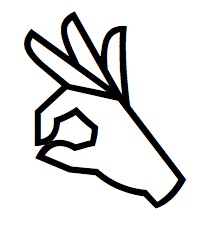



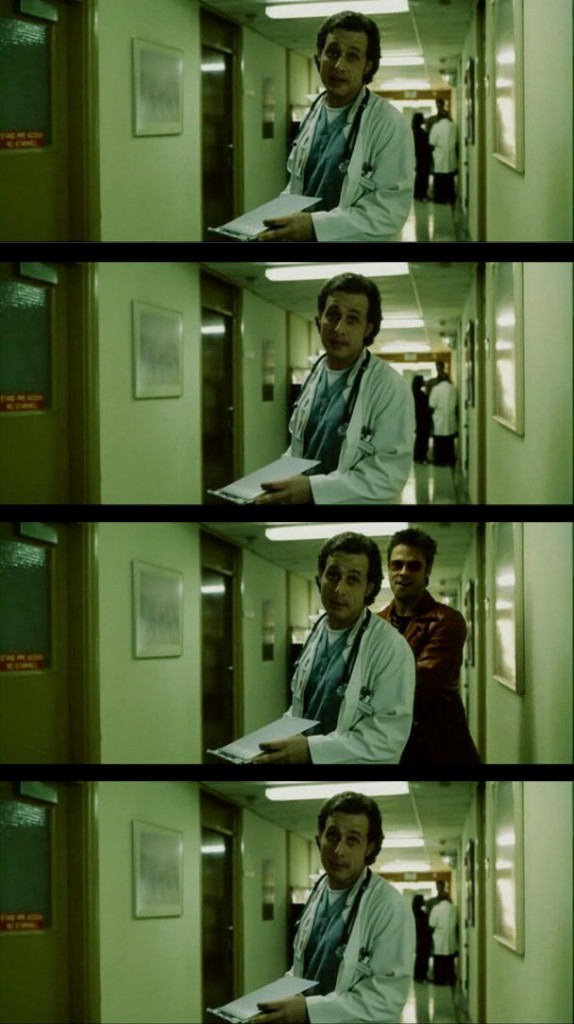
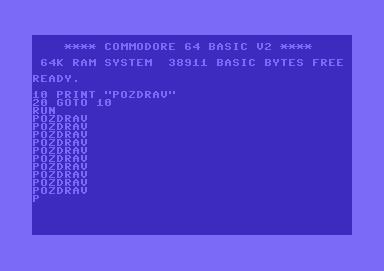

dare 09:31 on 26 Sep. 2010 Permalink
“…potem ko sem en teden veselo kazal A-ok…”
si mislil, da si kazal.
v resnici si kazal “that’s so gay, man”.
Nejc 12:56 on 2 Nov. 2010 Permalink
Kot potapljač tudi jaz odobravanje pokažem s potapljaškim OK. Pa sem pogosto ugotovil, da večina ljudi tega ne razume in te potem čudno gledajo 🙂
Sedaj se poskušam navaditi na Thumbs Up